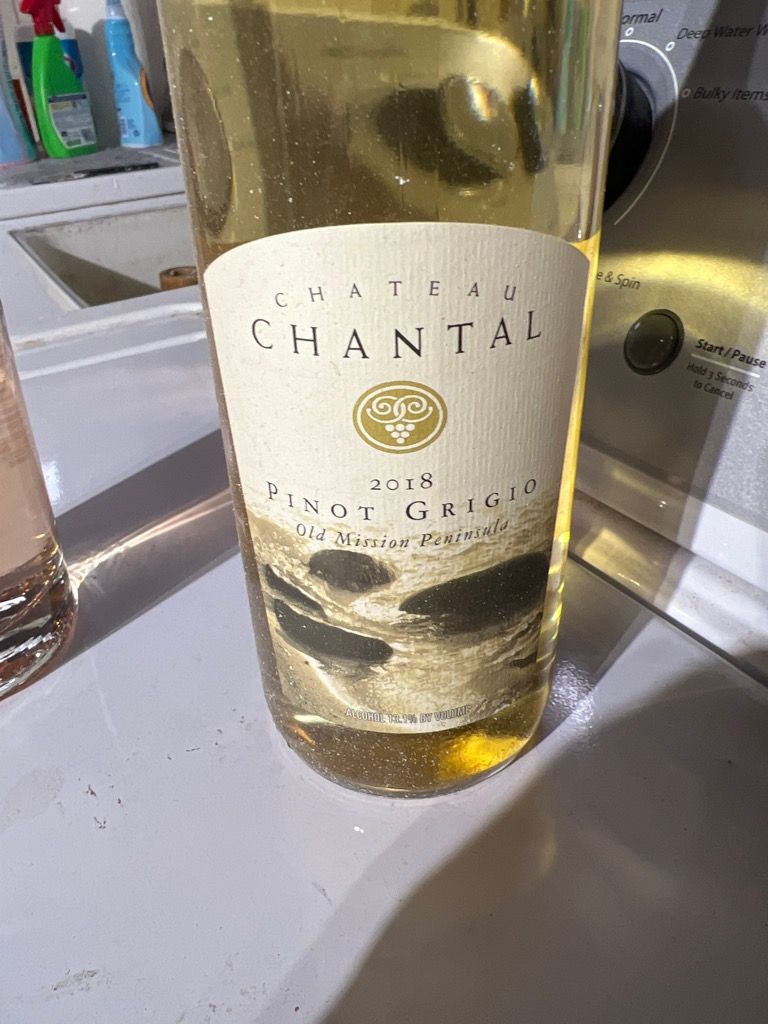
External search
Google (images)
Wine Advocate
Wine Spectator
Burghound
Wine-Searcher
Vintages
2021
2020
2018
2016
2015
2012
2011
2008
2007
2005
1994
From this producer
Show all wines
All tasting notes
|
| Drinking Windows and Values |
| Drinking window: Drink between 2023 and 2024 (based on 4 user opinions) |
| Community Tasting History |
| Chateau Chantal Producer web sitePinot GrisFrom Pinot Gris Wikipedia entry:
Wines made from the Pinot gris vary greatly and are dependent on the region and wine making style they are from. Alsatian Pinot gris are medium to full bodied wines with a rich, somewhat floral bouquet. They tend to be spicy in comparisons with other Pinot gris. While most Pinot gris are meant to be consumed early, Alsatian Pinot gris can age well. German Pinot gris are more full-bodied with a balance of acidity and slight sweetness. In Oregon the wines are medium bodied with a yellow to copper-pink color and aromas of pear, apple, and/or melon. In California, the Pinot gris are more light bodied with a crisp, refreshing taste with some pepper and arugula notes. The Pinot grigio style of Italy is a light-bodied, often lean wine that is light in color with sometimes spritzy flavors that can be crisp and acidic. Although this wine can be very sweet, it will begin to lose its acidity when it is nearly ripe.
Pinot gris is considered an "early to market wine" that can be bottled and out on the market within 4–12 weeks after fermentation.
Varietal character (Appellation America)
Conseillé pour l'apéritif et avec les mets suivants :
Foie Gras terrine
Foie Gras poęlé
Tarte tatinUSAAmerican wine has been produced since the 1500s, with the first widespread production beginning in New Mexico in 1628. Today, wine production is undertaken in all fifty states, with California producing 84% of all U.S. wine. The continent of North America is home to several native species of grape, including Vitis labrusca, Vitis riparia, Vitis rotundifolia, and Vitis vulpina, but the wine-making industry is based almost entirely on the cultivation of the European Vitis vinifera, which was introduced by European settlers. With more than 1,100,000 acres (4,500 km2) under vine, the United States is the fourth-largest wine producing country in the world, after Italy, Spain, and France.Michigan Michigan Wines (Michigan Grape and Wine Industry Council)Old Mission Peninsulaa note from John Trombley, in part borrowed from a comment on Left Foot Charley Pinot Gris:
The general central region of the Old Mission Peninsula was earliest farmed (late 1970s) and is now intensely farmed for grapes since the first V. Vinifera plantation in this quite contoured area, perhaps the most contoured on the peninsula. Nearby are Tale Feathers vineyard, the home vineyards of Chateau Grand Traverse, the Shangri La, Too vineyard, the Prairie School vineyard, the Manigold vineyard of Gewurztraminer fame, and so forth; this is not exhaustive. For the whites, Riesling and the Pinots are predominant, in the region; for the reds, Pinot Noir, Gamay, and Dornfelder are found. We may guess the soils: reef and mostly igneous sands from the Canadian Shield in the form of glacial till; various clays, mostly alkaline; and some humus from Recent forestation and human use. These are almost universal in varying amounts here. The vineyards here are mostly West-facing, flowing down from Center Road M-37 and the scenic outlook at the top of the center ridge down to the water line, with secondary elevations and depressions. (Early on it was somewhat recontoured to change ground-water issues that might have been problematic just west of the outlook.)
In general, this means the regional vineyards are very fine for ripening grapes but are prone to weather-related accidents: spring frosts and hail, and as elsewhere, requite strict attention to vineyard hygiene and canopy management in the intense summer sun and fog/rain that tend to alternate here. The wines are bright, energetic in the citruc range, somewhat rustic, and resinous, with best Pekoe and Pu'er tea notes that remind one of opening a ream of pine wood -based Kraft paper. This may be the signature nose and palate (terroir) of the Up-North (northern Lower Peninsula) white wines. |
|




